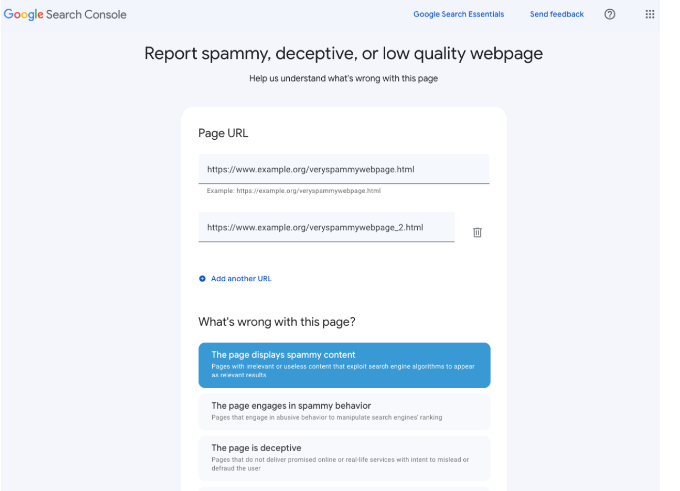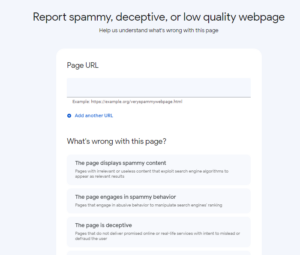How to Submit Spammy, Deceptive, and Low Quality Web Pages to Google

Google has provided a form for us to report low-quality, misleading, or spammy websites. You can report up to five URLs at once for violating the same Google guidelines. According to Google’s blog post, the issue goes beyond spam. Search quality issues such as spam, paid links, malicious activity, poor quality, and more may now be reported using a single, streamlined form.
When submitting the form, Google asks that you include a reference to the relevant spam policy.
We want practical suggestions for enhancing our algorithms. For this reason, we’ve made it possible to further specify the nature of the problem you’re reporting by selecting both a broad category and a more specific subcategory. While only one top-level problem category can be chosen per submission, many problems of the same type can be presented in the following stage.

Our form includes a link to a help page with an explanation of various quality issues, as well as references to our Spam regulations, to assist you in making the appropriate category selection. You can resubmit the form with the same page and choose various categories if you think the page has problems in several separate areas at once. However, in order to cut down on spam, our system will ignore duplicate reports submitted by the same person.
Google Search Console houses the form at https://search.google.com/search-console/report-spam. As a result, Google will be able to attribute the information to its original source. Unless you have a Google Account that can’t be traced back to you or your site, I don’t think there’s a way to file a report anonymously. In other words, if you don’t want Google to know that you’re submitting reports on your competitors, you shouldn’t log into the Google Account that is linked to the verified websites. Otherwise, Google would know both that you’re sending a report and whose websites you’ve verified in your account. Don’t submit your own website’s pages using this form; it goes without saying, but I’ll say it anyway. On the other hand, you might succeed in getting Google to crawl the page you upload there.
When submitting the report, you will be asked to “classify” it into one of several categories.
- Spam is displayed on this page. Spam is information on a website that is designed to trick search engines into thinking it is relevant when it is not.
- In order to manipulate search engine rankings, this page participates in spamming conduct.
- That page is full of lies. Sites that intentionally mislead or cheat users out of money by promising services they cannot provide either online or in person
- The page’s quality is poor – Badly written or designed page that exists only to garner clicks from people rather than providing genuine information or entertainment.
- There are sponsored links on this page. Pages with or receiving inbound/outbound links that are/appear to be unnatural, false, misleading, or manipulative
- Anything else that can be considered search engine abuse or exploitative SEO strategy
What I think Google might do is take these reports and feed them into a new “system” so to speak, and have their automated system filter out the reports in some way. After that, the system(s) in question would either address the problem (automatically, if possible) or flag it for human review. They have stated that when a manual action (Google penalty) is placed on a website, it is reviewed by a human, thus it is quite plausible (I’m assuming here) that the data from these reports will make its way into another system.
It remains to be seen what Google does with all of this information, but I think it’s a start in helping Google reevaluate pages that users think are spammy, misleading, and low quality.







